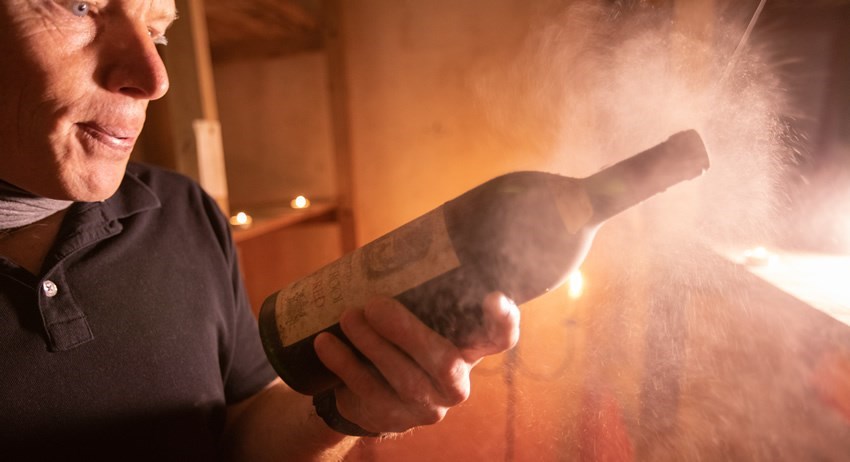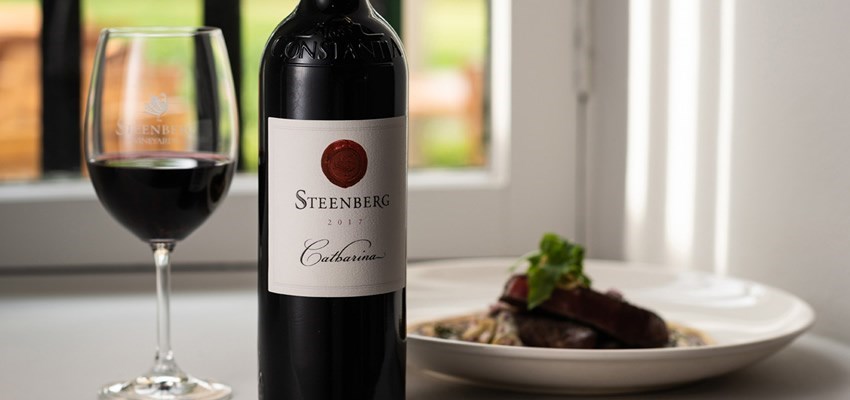Constantia is the birthplace of wine tourism in the new world, celebrated by Charles Dickens, Jane Austen, Baudelaire, Bismarck and Napoleon. On 2 February 2021, Groot Constantia, the oldest wine farm south of the equator, celebrated the first harvest in the Cape in 1659 with a virtual event which drew over 3000 viewers. Marking the tenth anniversary of its annual commemoration in high-tech style, to comply with Covid19 regulations, the old met the new in a podcast seen around the world.
In mid-February, Groot Constantia (1685) unveiled its fascinating vintage vault at one of the first media events since the lifting of the third alcohol ban in South Africa. We were treated to a real tasting of some of the vintage wines stored in the old underground kuipe (tanks), at an atmospheric underground food and wine pairing. Staying power is the signature of South Africa’s oldest wine farm, where CEO Jean Naude and winemaker Boela Gerber (2001) have spent the last two decades.
“Groot Constantia is older than Cabernet Sauvignon” declared Boela. Now there’s a sense of perspective for you. The king of red grapes was first planted in France in the late 1600s – and only established a century later when the great cellars of Bordeaux adopted the variety with enthusiasm. When Professor Perold, one of the pioneers of viticulture in South Africa, visited France a century ago, he returned full of fervour for Cabernet Sauvignon – an exciting new variety he advocated planting in Constantia and Stellenbosch. Today, it is the backbone of the Gouverneurs Reserve.
Since 2002, Groot Constantia has archived up to 1200 bottles of every vintage – including its award-winning Chardonnay 2013 (voted Best in World), Sauvignon Blanc 2019 (IWC) and Shiraz – and is now slowly releasing the wines stored in its vintage vault. Older rare museum vintages showcase the iconic Grand Constance 1821,JP Cloete’s Pontac which won acclaim at the International Exhibition in Paris in 1855 and bottles of Constantia made for the Duke of Northumberland in 1791. We tasted the flagship Gouverneurs Reserve 2005, the first limited release from the vintage vault (R1750 per bottle) – as well as Grand Constance 2007 – in intriguing pairings of older and current releases.

Every variety tells a story at Groot Constantia – from Cabernet Sauvignon and Pontac to Shiraz, first made at Groot Constantia way back in 1724, as well as the only Pinotage made in the Constantia Wine Valley today. Cuttings from the farm were transplanted to the first vineyards of Australia. Centuries later, the viticulturists still pay great attention to detail in the vineyards to create elegant, cool climate wines. Some 25-30% of sales are at the cellar-door – which combined with the living museums, tastings and restaurants draws400 000 visitors annually to one of the top ten tourist attractions in the Western Cape. CEO Jean Naude says the absence of foreign tourists over the lockdown season has hit hard – but loyal local support and cellar door sales are sustaining the farm.
Heading higher up the slopes of the valley towards Constantia Nek, I revisited Constantia Glen, one of the dozen or so wine farms on the Constantia wine route today. Winemaker Justin van Wyk (2011) hosted a vertical flight of Constantia Glen Two, their flagship white blend of Sauvignon Blanc and Semillon, the signature white wine of the Constantia Wine Valley. Over a tasting of vintages between 2011-2019, Justin commented “This is the essence of Constantia, the style of wine most suited to the farm, valley and region. We make this barrel-fermented wine in an old-world Sancerre style with texture, waxy weight and minerality. Semillon is a heritage variety in Constantia, once known as groendruif. The wine has more ageability and complexity than straight Sauvignon Blanc.”
Over a fabulous tasting and lunch with a spectacular elevated view of the upper vineyards of Constantia, CEO Gus Allen spoke about the record 115 000 visitors to Constantia Glen in 2019 before Covid19. Loyal local support, cellar-door sales, tastings and patronage of their acclaimed restaurant are a winning formula – as well as a 50% export margin. Their award-winning white Bordeaux blend, Constantia Two is a best-seller in Europe – but a tougher sell in South Africa. The farm specialises in elegant Bordeaux-style white and red blends in a cool-climate style under dryland conditions. Justin was starting to pick his eleventh vintage of Constantia Glen Two the day we enjoyed the tasting. The grapes are picked from the best blocs, fermented in French and Austrian oak, acacia and amphorae.
Justin van Wyk has also been a key player in the making of two vintages of the signature Constantia Sauvignon Blanc/Semillon blend made since 2018 from grapes supplied by eight key producers in the valley. Wade Bales, the Constantia-based negociant behind this initiative, was present at the tasting. One of the Cape’s smallest, and most boutique appellations at 430 ha under vine (0,4% of the national vineyard), the Constantia Wine Valley is also one of the most focused on cool climate white varieties like Sauvignon Blanc (over 50% of plantings) and Semillon, an old heritage variety.
Constantia is a magical wine brand, a marketing dream, the birthplace of South African and new world wine. Over the last two decades the heritage estates of Groot Constantia, Klein Constantia, Buitenverwachting and Steenberg have been joined by new boutique producers such as Constantia Glen, Constantia Royale, Constantia Mist, Constantia Nectar, High Constantia, Eagle’s Nest and Silvermist. It is also one of the most affluent suburban belts and lifestyle destinations in South Africa with high resident and summer swallow spend by foreign visitors who return here every year. Without holidays abroad over the pandemic, there may be more local spend by domestic tourists.
Eating and drinking my way around the Constantia Wine Valley in February, I was struck by the thriving gastronomic scene and staying power of local patronage. Constantia is home to a handful of South Africa’s top restaurants and top chefs today, inter alia, chefs Scot Kirton La Colombe at Silvermist (World’s 50 Best Restaurants, Eat Out restaurant of the Year), Liam Tomlin and Ivor Jones at Chefs Warehouse at Beau Constantia, Foxcroft, Peter Tempelhoff’s Beyond at Buitenverwachting, Kerry Kilpin at Tryn and Bistro Sixteen82 at Steenberg, Greenhouse and The Conservatory at Cellars Hohenort, the Blockhouse Kitchen at Constantia Uitsig, Constantia Glen, the Chardonnay Deli, The Bistro at Klein Constantia, Jonkershuis at Groot Constantia. The Constantia A-list goes on and on.
My journey through Constantia was a story of big blends. At Tryn at Steenberg, cellar master Elunda Basson (2019) hosted a vertical flight of Catharina, the flagship red blend of one of the valley’s top lifestyle destinations. Named after Catherina Ras, the founding matriarch of the wine farm, the Catharina blend was first made in 1997 – and at one stage featured five varieties for each of her five husbands! Made in turn by legendary Steenberg winemakers Nicky Versveld, John Loubser and JD Pretorius, Catharina 2017 has been reimagined as a Bordeaux-style blend led by the farm’s signature Merlot augmented by Cabernet Sauvignon, Malbec and Petit Verdot – but no longer Shiraz.

Elunda explains, “I’d like the blend to have some consistency. The Constantia terroir has been quite a revelation for me. Steenberg represents cool-climate wines and styles – elegant wines with longevity. Catharina represents the best red grapes of the vintage – based on Merlot (10/60 ha), which does very well here. As a flagship, terroir-based blend of authenticity and clarity it needs time to develop.” She will have to wait two vintages to stamp her signature on the 2019 vintage – but in the meantime has released her first two Steenberg Sauvignon Blancs, the cellar’s hero white grape – the vibrant Steenberg Sauvignon 2020 and lightly wooded Rattlesnake Sauvignon. Watch this space.
The week we visited, Steenberg had hosted a very special guest at Steenberg. In a show of support for the beleaguered wine tourism industry, President Cyril Ramaphosa brought his family for Sunday lunch at Tryn on a discrete, unannounced private visit. On a walkabout of the restaurant, other guests recognised and warmly greeted him as he enjoyed the food, wine and spectacular views. Even a head of state has to take the day off occasionally – and where better to spend it than Constantia?